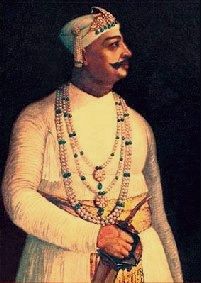|
Sikander Jah, Asaf Jah III
Sikander Jah, Asaf Jah III (11 November 1768 – 21 May 1829), was the 3rd Nizam of Hyderabad, India from 1803 to 1829.[1] He was born in Chowmahalla Palace in the Khilwath, the second son of Asaf Jah II and Tahniat un-nisa Begum. Family
One of his wives was Jahan Parwar Begum, also known as Hajji Begum.[2] She was the daughter of Azim ul-Umara[3] also known as Ma'ali Mian and Farzand Begum. She was the granddaughter of Aristu Jah, from whom she inherited Purani Haveli (lit. "Old mansion"),[2] and the niece of Munir ul-Mulk.[3] She was the mother of Mir Tafazzul Ali Khan, also known as Mir Badsha,[4] and Namdar-un-Nisa Begum.[5] She died on 21 May 1853.[6] Another wife was Fazilat-un-nisa Begum also known as Chandni Begum. She was the mother of Nasir-ud-Daulah and Mubarez-ud-Daulah.[7]
Official nameHis original names were Sikandar Jah, Asaf ul-Mulk, Asad ud-Daula, Walashan Nawab Mir Akbar 'Ali Khan Siddiqi Bahadur, Asad Jang. He was officially known as Asaf Jah III, Nizam ul-Mulk, Nizam ud-Daula, Mir Akbar 'Ali Khan Siddiqi Bahadur, Faulad Jang, Nizam of Hyderabad.[13] Military expansionDuring his reign, a British cantonment was established near Hyderabad and the area was christened after him as Secunderabad. His son Samsamadaula (Mir Basheeruddin Ali Khan) was Defence Adviser to his brother, Nasir ud Daula, and nephew, Afzal ud daula. But he did not have any pact with the British for maintaining the contingent. The state was in a financial mess during his reign.[14][15] Sikh RegimentUpon the recommendation of Maharaja Chandu Lal, a Punjabi Khatri and influential dignitary at the Nizam's court. 1200+ Sikh soldiers joined the Nizam's army. Around 1830, Maharaja Ranjit Singh sent 150 more men under a Sardar Chanda Singh, for the construction of Gurdwara Takht Sachkhand Sri Hazur Sahib Abichalnagar at Nanded.[16][17] Building of templeSikander Jah not only built the Rambagh temple in Attapur, Hyderabad but also attended the inauguration ceremony proving again the communal harmony that existed between the Muslim Asaf Jahi rulers and their Hindu subjects in Hyderabad. The Nizam also granted a Jagir to the temple priest for the temple's maintenance.[18][19] See alsoReferences
Bibliography
External linksWikimedia Commons has media related to Mir Akbar Ali Khan Sikander Jah, Asaf Jah III. |
||||||||||||||||||||||||||||||||||||
Portal di Ensiklopedia Dunia

